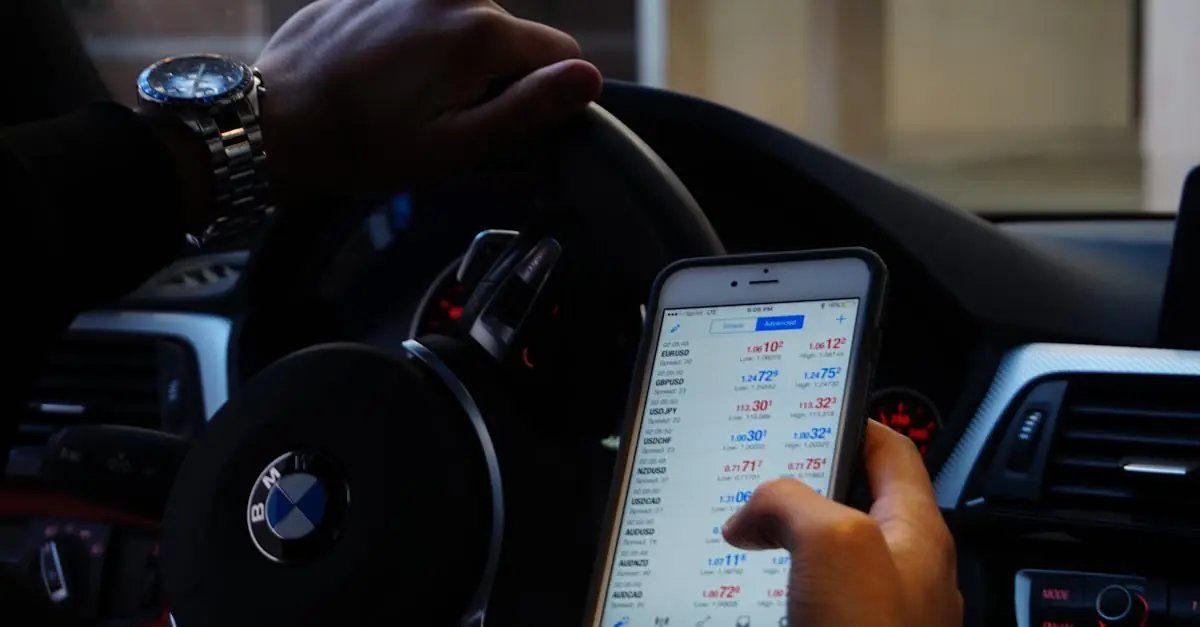In a world where money seems to vanish faster than socks in a dryer, a personal finance dashboard is like having a superhero sidekick for your wallet. It swoops in to save the day, offering a clear view of your spending habits, savings goals, and investment opportunities. Imagine having all your financial data neatly organized, so you can finally stop playing hide and seek with your bank statements.
Table of Contents
ToggleOverview of Personal Finance Dashboards
Personal finance dashboards serve as essential tools for tracking financial information in one centralized location. These platforms simplify money management by presenting data clearly, enabling individuals to make informed decisions.
What Is a Personal Finance Dashboard?
A personal finance dashboard is a digital interface that aggregates financial data. Users access features like income tracking, expense management, and budgeting tools. Dashboards typically display graphs and charts, offering visual representations of spending habits. These tools can also sync with bank accounts, providing real-time updates. Various applications exist, each catering to different financial needs.
Importance of Tracking Personal Finances
Tracking personal finances plays a crucial role in achieving financial goals. Clear visibility into spending patterns helps identify areas for improvement. Regular monitoring of financial habits promotes responsible budgeting. Additionally, tracking aids in preparing for unexpected expenses. Individuals equipped with precise financial information make proactive decisions. Tools that offer detailed insights into income and expenses enhance overall financial literacy.
Key Features of Personal Finance Dashboards
Personal finance dashboards offer various features to streamline money management. Users benefit from tools designed to track and analyze their financial health efficiently.
Budgeting Tools
Budgeting tools form the backbone of most personal finance dashboards. These tools allow users to create personalized budgets based on their income and expenses. Tracking monthly spending becomes easier with detailed categorizations such as groceries, entertainment, and utilities. Users can set limits for each category, promoting disciplined financial behavior. Over time, tracking actual spending against set budgets helps identify trends and areas for adjustment.
Expense Tracking
Expense tracking is another critical feature in personal finance dashboards. This capability allows individuals to monitor daily expenses in real-time. Integration with bank accounts and credit cards automates data entry, ensuring accuracy. Users can categorize transactions for better insights into spending habits. This visibility encourages responsible spending and helps identify discretionary expenses that could be reduced.
Financial Goals Monitoring
Financial goals monitoring empowers users to stay focused on their objectives. Personal finance dashboards enable individuals to set specific savings targets for emergencies, vacations, or major purchases. Tracking progress toward these goals provides motivation and accountability. Regular updates on goal status allow users to adjust strategies when necessary, ensuring they remain on track. This feature enhances overall financial awareness, reinforcing the importance of goal-oriented savings strategies.
Popular Personal Finance Dashboard Tools
Several personal finance dashboard tools help individuals manage their finances efficiently. Each offers unique features tailored to different financial needs.
Tool 1: Overview and Features
Mint stands out as a popular option for users looking to track expenses and create budgets. This tool automatically syncs with bank accounts, credit cards, and investment platforms, pulling real-time data into one cohesive dashboard. Users appreciate its intuitive interface that allows for category tracking, goal setting, and expense monitoring. Alerts and reminders help users stay informed about due dates, promoting timely payments and avoiding fees. Comprehensive graphs visualize spending patterns, enabling users to make informed decisions about their finances.
Tool 2: Overview and Features
YNAB (You Need a Budget) focuses on proactive budgeting strategies designed to allocate every dollar effectively. It encourages users to assign roles to their income, ensuring each dollar serves a purpose. With customizable budget categories, users can adapt the tool to their unique financial situations. Real-time updates of spending allow users to adjust their budgets as needed. The educational resources provided by YNAB enhance financial literacy, making it suitable for users aiming to improve their budgeting skills.
Tool 3: Overview and Features
Personal Capital caters to those interested in wealth management alongside budgeting. This tool tracks investments, providing insights into portfolio performance and asset allocation while allowing users to understand their net worth. Features such as retirement planning calculators support users in setting long-term financial goals. Users can sync bank accounts and credit cards, offering a comprehensive view of their financial landscape. Additionally, Personal Capital provides personalized advice, guiding users toward smarter investment choices.
Benefits of Using a Personal Finance Dashboard
Utilizing a personal finance dashboard provides numerous advantages for individuals seeking to manage their finances effectively. These tools enhance clarity around financial situations and streamline decision-making processes.
Enhanced Financial Awareness
Increased financial awareness results from using a personal finance dashboard. Users gain visibility into spending habits, helping them identify patterns that may require adjustment. Observing categorized expenses enables informed choices regarding necessary and discretionary spending. Tracking income alongside expenditures promotes accountability, highlighting areas where savings can occur. Consequently, individuals become more conscious of their financial health over time, driving responsible budgeting practices.
Simplified Financial Planning
Financial planning becomes more straightforward with a personal finance dashboard. Users can set up customized budgets that reflect their unique needs, allowing for targeted financial goals. Tracking progress toward savings goals fosters motivation and encourages proactive decision-making. By aggregating different financial accounts in one location, these dashboards eliminate the need for juggling multiple spreadsheets or statements. This centralized approach simplifies monitoring of expenses and income, making it easier for users to adapt to changing circumstances while staying focused on their financial objectives.
Embracing a personal finance dashboard can transform the way individuals manage their finances. By providing a comprehensive view of spending habits and savings goals it empowers users to take control of their financial journey. The clarity offered by these dashboards not only simplifies budgeting but also enhances financial literacy.
With tools tailored to various needs individuals can find the right fit for their financial management style. Regularly engaging with a personal finance dashboard fosters accountability and prepares users for unexpected expenses, ultimately leading to improved financial health. Adopting this technology is a proactive step toward achieving financial stability and reaching long-term financial goals.



